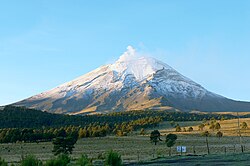
Back Puebla (estau) AN ولاية بويبلا Arabic Puebla AST Puebla Istadu Aymara Puebla BAN Puebla (Bundesstoot) BAR Пуэбла (штат) Byelorussian Пуэбля (штат) BE-X-OLD Пуебла (щат) Bulgarian Puebla (stad) Breton
Puebla | |
|---|---|
| Free and Sovereign State of Puebla Estado Libre y Soberano de Puebla (Spanish) Tlahtohcayotl Puebla (Nahuatl) | |
 | |
| Motto(s): Unidos En El Tiempo, En El Esfuerzo, En La Justicia y En La Esperanza(United in time, effort, justice and hope) | |
| Anthem: Himno al Estado de Puebla | |
 State of Puebla within Mexico | |
| Coordinates: 19°0′N 97°53′W / 19.000°N 97.883°W | |
| Country | Mexico |
| Capital and largest city | Puebla de Zaragoza |
| Largest metro | Greater Puebla |
| Municipalities | 217 |
| Admission | December 21, 1823[1] |
| Order | 4th |
| Government | |
| • Governor | Sergio Salomón Céspedes |
| • Senators[3] | Alejandro Armenta Mier Nancy de la Sierra Aramburo Nadia Navarro Acevedo |
| • Deputies[4] | |
| Area | |
• Total | 34,306 km2 (13,246 sq mi) |
| Ranked 21st | |
| Highest elevation | 5,610 m (18,410 ft) |
| Population (2020)[7] | |
• Total | 6,583,278 |
| • Rank | 5th |
| • Density | 190/km2 (500/sq mi) |
| • Rank | 6th |
| Demonym | Poblano (a) |
| GDP | |
| • Total | MXN 903 billion (US$44.9 billion) (2022) |
| • Per capita | (US$6,736) (2022) |
| Time zone | UTC−06:00 (CST) |
| Postal code | 72-75 |
| Area code | |
| ISO 3166 code | MX-PUE |
| HDI | |
| Website | www |
Puebla,[a] officially the Free and Sovereign State of Puebla,[b] is one of the 31 states that, along with Mexico City, comprise the Federal Entities of Mexico. It is divided into 217 municipalities and its capital is Puebla City. Part of east-central Mexico, it is bordered by the states of Veracruz to the north and east, Hidalgo, México, Tlaxcala and Morelos to the west, and Guerrero and Oaxaca to the south. The origins of the state lie in the city of Puebla, which was founded by the Spanish in this valley in 1531 to secure the trade route between Mexico City and the port of Veracruz. By the end of the 18th century, the area had become a colonial province with its own governor, which would become the State of Puebla, after the Mexican War of Independence in the early 19th century. Since that time the area, especially around the capital city, has continued to grow economically, mostly through industry, despite being the scene of a number of battles, the most notable of which being the Battle of Puebla. Today, the state is one of the most industrialized in the country, but since most of its development is concentrated in Puebla and other cities, many of its rural areas are undeveloped.
The state is home to the china poblana, mole poblano, active literary and arts scenes, and festivals such as Cinco de Mayo, Ritual of Quetzalcoatl, Day of the Dead celebrations (especially in Huaquechula) and Carnival (especially in Huejotzingo). It is home to five major indigenous groups: Nahuas, the Totonacs, the Mixtecs, the Popolocas and the Otomi, which can mostly be found in the far north and the far south of the state.
- ^ "Las Diputaciones Provinciales" (PDF) (in Spanish). p. 15.
- ^ "Senadores de la República por Entidad Federativa" (in Spanish). Retrieved 4 February 2017.
- ^ "Senadores por Puebla LXI Legislatura". Senado de la Republica. Retrieved April 5, 2011.
- ^ "Listado de Diputados por Grupo Parlamentario del Estado de Puebla". Camara de Diputados. Archived from the original on July 20, 2018. Retrieved April 5, 2011.
- ^ "Resumen". Cuentame INEGI. Archived from the original on April 1, 2012. Retrieved February 12, 2013.
- ^ "Relieve". Cuentame INEGI. Archived from the original on April 1, 2012. Retrieved April 5, 2011.
- ^ "México en cifras". January 2016.
- ^ Citibanamex (June 13, 2023). "Indicadores Regionales de Actividad Económica 2023" (PDF) (in Spanish). Retrieved August 13, 2023.
Cite error: There are <ref group=lower-alpha> tags or {{efn}} templates on this page, but the references will not show without a {{reflist|group=lower-alpha}} template or {{notelist}} template (see the help page).
